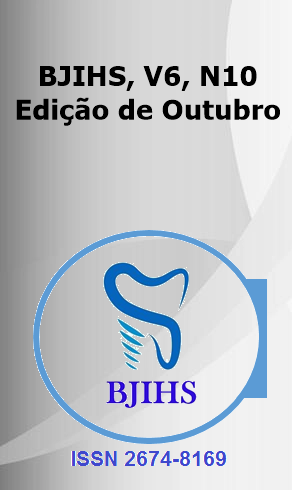Resumo
Colles fracture, first described in 1814, is characterized by the dorsal displacement of the distal radius fragment and is highly prevalent, particularly among elderly patients. This study aims to evaluate the effectiveness of Open Reduction and Internal Fixation (ORIF) in treating Colles fractures, focusing on functional outcomes and postoperative quality of life. An integrative literature review and comparative analysis of studies on ORIF and other treatment methods were conducted using Google Scholar, Scopus, and Web of Science as indexing tools. Articles were selected using the keywords “Colles Fracture, Open Reduction and Internal Fixation, Functional Outcomes, Postoperative Complications.” The review highlights that ORIF generally provides superior functional outcomes and fewer complications in various fractures, such as those of the humerus, tibial pilon, calcaneus, and unstable distal radius fractures, compared to less invasive methods like external fixation (EF). However, EF shows advantages in specific cases, such as shorter surgical time and fewer perioperative complications. Moreover, the studies indicate that risk factors like diabetes, fracture severity, lack of drainage, and bone graft usage increase the risk of complications in ORIF. Additionally, minimally invasive techniques can reduce pain and enhance functional recovery in certain fractures, such as patellar fractures, when compared to ORIF.
Referências
CARR, Deborah et al. Posterior-based approaches to open reduction internal fixation of Bimalleolar and trimalleolar fractures: a systematic review and meta-analysis. The Journal of Foot and Ankle Surgery, v. 59, n. 2, p. 373-378, 2020.
CUI, Xueliang et al. Two-stage open reduction and internal fixation versus limited internal fixation combined with external fixation: a meta-analysis of postoperative complications in patients with severe Pilon fractures. Journal of International Medical Research, v. 46, n. 7, p. 2525-2536, 2018.
GOUK, Conor et al. Long term outcomes of open reduction internal fixation versus external fixation of distal radius fractures: A meta-analysis. Orthopedic reviews, v. 11, n. 3, 2019.
LO, Chun-Hong; CHEN, Chih-Hwa. Comparison of minimally invasive percutaneous fixation and open reduction internal fixation for patella fractures: a meta-analysis. Journal of Orthopaedic Surgery and Research, v. 16, p. 1-13, 2021.
SHARMA, Siddhartha et al. Surgical approaches for open reduction and internal fixation of intra-articular distal humerus fractures in adults: a systematic review and meta-analysis. Injury, v. 49, n. 8, p. 1381-1391, 2018.
TRIPATHY, Sujit Kumar et al. External fixation versus open reduction and internal fixation in the treatment of Complex Tibial Plateau Fractures: A systematic review and meta-analysis. Acta Orthop Traumatologica Turcica, v. 55, p. 444-456, 2021.
WANG, Weiguo et al. RETRACTED ARTICLE: Open reduction and closed reduction internal fixation in treatment of femoral neck fractures: a meta-analysis. BMC musculoskeletal disorders, v. 15, p. 1-5, 2014.
WANG, Yiyang et al. Arthroscopy assisted reduction percutaneous internal fixation versus open reduction internal fixation for low energy tibia plateau fractures. Scientific Reports, v. 8, n. 1, p. 14068, 2018.
WU, Jianbin et al. Percutaneous reduction and fixation with Kirschner wires versus open reduction internal fixation for the management of calcaneal fractures: a meta-analysis. Scientific reports, v. 6, n. 1, p. 30480, 2016.
YUAN, Z. Z. et al. Complications following open reduction and internal fixation versus external fixation in treating unstable distal radius fractures: grading the evidence through a meta-analysis. Orthopaedics & Traumatology: Surgery & Research, v. 104, n. 1, p. 95-103, 2018.
ZARKADIS, Nicholas J. et al. Open reduction–internal fixation versus intramedullary nailing for humeral shaft fractures: an expected value decision analysis. Journal of shoulder and elbow surgery, v. 27, n. 2, p. 204-210, 2018.
ZHANG, Wei et al. Risk factors for wound complications of closed calcaneal fractures after surgery: a systematic review and meta-analysis. Scandinavian journal of trauma, resuscitation and emergency medicine, v. 23, p. 1-11, 2015.
ZHAO, Xing-wen et al. A meta-analysis of external fixation versus open reduction and internal fixation for complex tibial plateau fractures. International Journal of Surgery, v. 39, p. 65-73, 2017.

Este trabalho está licenciado sob uma licença Creative Commons Attribution 4.0 International License.
Copyright (c) 2024 Iasmim Camila Chaves Pessoa, Sylvia Ferreira Grisi Paiva, Eduardo Eugênio Miranda Alencar, João Vitor Cunha Lima Paranhos, Maria Eduarda de Melo Silva Pessoa, Bruno de Vasconcelos Braga, Paulo André Jordão de Paiva Serpa, Ariana Nicol Eugenio Vela, Matheus Cortizo Carballal, Karla Emanuelly Cassemiro da Silva, Leonardo Barroso de Moraes Santos, Márcio Moreira Saraiva Ribeiro, Victória Rocha Pereira da Silva, Fernando Antônio Ferreira de Andrade Júnior, Mariana Moura de Luna Souza, Maria Eduarda Pontes Beltrão, Maria Fernanda Dias Correa de Araújo, Amanda Diely Brito Bulhões da Silva
